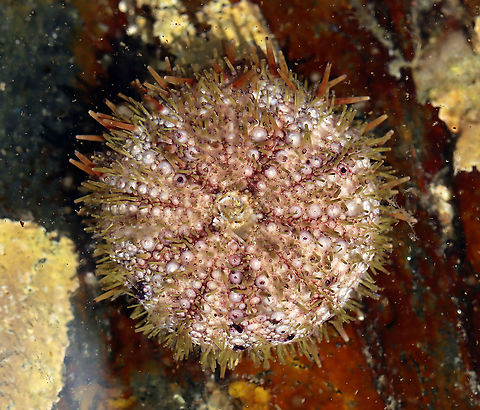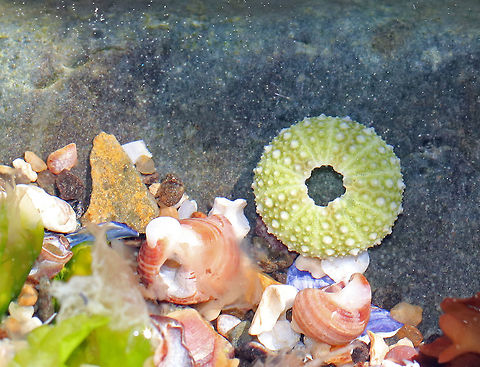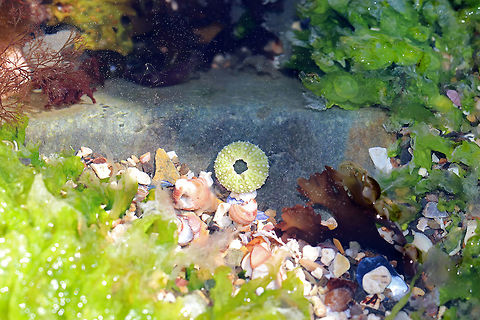
Appearance
The average adult size is around 50 mm, but it has been recorded at a diameter of 87 mm.''Strongylocentrotus droebachiensis'' is in the shape of a slightly flattened globe. The oral side rests against the substratum and the aboral side is in the opposite direction. It has pentameric symmetry, which is visible in the five paired rows of podia that run from the anus to the mouth. The size is calculated as the diameter of the test. This is a relatively fast growing sea urchin, and its age is generally calculable based on its size: one year for every 10 mm.

Habitat
''Strongylocentrotus droebachiensis'' is found on rocky substratum in the intertidal and up to depths of 1,150 meters.It uses its strong Aristotle's lantern to burrow into rock, and then can widen its home with the spines. Usually, this sea urchin can leave its hole to find food and then return, but sometimes it creates a hole that gets bigger as it gets deeper, so that the opening is too small for ''S. droebachiensis'' to get out.
''S. droebachiensis'' is a euryhaline species, and can survive in waters of low salinity. This allows it to flourish in the south Puget Sound. Acclimation and size are important factors as larger individuals have a lower surface area to volume ratio and can handle the increased osmotic tension.Snails of the families Melanellidae and Stiliferidae live on the surface of the test and adhere their own eggs to the base of the spines as protection.

Reproduction
Sea urchins are dioecious, meaning they either contain male or female reproductive organs. They contain five gonads tucked under the test. These are located close to the anus and are protected by genital plates. One of these plates is perforated, and also acts as the madreporite. Sea urchins all release their eggs or sperm directly into the water column at the same time to ensure fertilization. It is not understood what causes ''S. droebachiensis'' to release their sperm or eggs, but it may have to do with temperature, because they usually reproduce in early spring.Once fertilized, the gamete grows via mitosis and eventually becomes a larva capable of simple swimming called an echinoplutes. The metamorphosis from larva to a radially symmetrical adult is hugely complex, and only some of the more basic details are included here. The larva swims to the appropriate substratum where it attaches, usually with the “left and right” sides of the larva, becoming the “mouth and anus” sides. The embryonic openings for the mouth and the anus disappear completely, and new openings are created in the proper position. The ring canal grows radial extensions becoming the lateral canals. At this point in development, the sea urchin settles down to a benthic life.
Food
The green sea urchin prefers to eat seaweeds but will eat other organisms.''S. droebachiensis'' feeds on algae, preferring species like ''Sargassum muticum'' and ''Mazzaella japonica'' over ''Saccharina latissima'', ''Ulva'', and ''Chondracanthus exasperatus''.
Predators
They are eaten by a variety of predators, including sea stars, crabs, large fish, mammals, birds, and humans.References:
Some text fragments are auto parsed from Wikipedia.